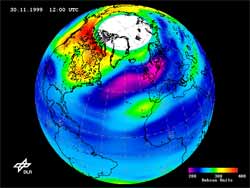Ozone holes in Antarctica: can not be predicted
 The ozone hole in Antarctica is now the third largest hole recorded, but the weather forecasters are still not sure how it will be in the future, according to the World Meteorological Organization (WMO). .
The ozone hole in Antarctica is now the third largest hole recorded, but the weather forecasters are still not sure how it will be in the future, according to the World Meteorological Organization (WMO). .
This gap widened up last month with nearly 27 million square kilometers, then began to shrink as usual. However, it is still large at the third level, after 2003 (28 million square kilometers) and 2000.
' Because we are not sure about climate change, we do not know if this hole will continue to grow like 2003 or even more in the near future ', Geir Braathen, ozone expert WMO said. ' However, it does not seem to grow very much and does not seem to change, ' he added.
The ozone hole was discovered in the 1980s, created by air and pollution, and changed abnormally depending on the season and the weather.
Ozone, a molecule of oxygen, is a stratosphere shield needed for life on Earth, preventing dangerous ultraviolet rays from the sun. These rays are harmful to plants and can cause skin cancer and cataracts. This protective layer is increasingly being damaged by artificial substances, especially bromine, chlorine and chlorofluorocarbons (CFCs).
T.VY ( According to Xinhua )
- Ozone holes can disappear by 2050
- The ozone layer has started to recover?
- Ozone holes in Antarctica show signs of shrinking
- The person who discovered the ozone layer hole died
- The ozone gap in Antarctica is the smallest in nearly 3 decades
- Why is the ozone hole concentrated in Antarctica?
- New discovery of the ozone layer gap in Antarctica
- Ozone holes appear in the North Pole
- Still need to be alert for ozone layer hole
- Ozone hole ... is shrinking
- Mysterious decoding of strange ice holes constantly appearing in Antarctica for decades
- How did NASA save people from the 'end of the world'?
 Is the magnetic North Pole shift dangerous to humanity?
Is the magnetic North Pole shift dangerous to humanity? Washington legalizes the recycling of human bodies into fertilizer
Washington legalizes the recycling of human bodies into fertilizer Lightning stone - the mysterious guest
Lightning stone - the mysterious guest Stunned by the mysterious sunset, strange appearance
Stunned by the mysterious sunset, strange appearance